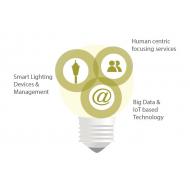The solution will be presented for the first time at the Light+Building fair, the most important lighting fair worldwide, which will take place on 13 to 18 March in Frankfurt Germany.
Current urban lighting management systems are mainly based on communication through power supply lines, known as Power Line Communication (PLC), centralised in a control panel.
These systems perform only basic remote management tasks on the lighting since they have different limitations preventing them from being considered under the concept of smart lighting. Firstly, as well as being linked to a control panel structure, the PLC networks have low data transfer capacity and a limited capacity for interaction between control system and lighting. Secondly, there is a problem of interoperability and expansion of the PLC networks, as different systems and protocols are not compatible. Thirdly, expanding the system with new applications is highly complex (because of updates, scalability and extensibility). Finally, PLC‐based systems are complex to install and maintain, and do not have high communication safety standards implemented.
ELT has based its CMS solution on monitoring capabilities, data acquisition and control of its new LED drivers which incorporate an advanced eSMART technology developed by ELT. This technology allows us to generate programmable real-time lighting profiles, according to the location of the lighting point, adapted to the environment and its characteristics, optimising energy consumption and cost. The CMS solution also provides information for preventive maintenance of the facilities, by measuring parameters related to the driver itself, the LED module and the electric grid; thus contributing to diagnostic and testing procedures and the efficient management of alarms and incidents.
Monitoring and control of the lighting network is done via a proprietary software package which incorporates a multi-device user friendly web-based interface with different modules and applications, different user profiles and based on a geographic representation of the lighting poles. This enables various facilities and lighting groups to be managed according to different logical criteria (individual, full installation, street and type, etc.).
To complete this first level of smart lighting and enable the second level, data management, a bidirectional communication system between the lighting and a data storage and processing platform is required, with the corresponding business intelligence capacity and the tools to present and display the results.
To implement the communication system, ELT has designed and manufactured specific devices to be installed on the lighting fixture exterior which are connected to the LED driver via a specific port; thus leading to the generation of a multi‐hop mesh network in the free ISM frequency band. The network protocol used is based on the 6LoWPAN standard protocol, proposed by the Internet Engineering Task Force (IETF) for Wireless Sensor Networks (WSN).
The mesh network lighting nodes communicate with the management platform via 2G/3G/4G Gateway nodes (hubs), also installed on the exterior of the lighting fixtures; these are distributed in number and positionally for sufficient redundancy and to avoid critical channels in the system. In addition to managing the nodes, the gateways are also responsible for their radius of influence and the synchronisation of events.
The communication devices, gateway and node, have an innovative and unique design which makes possible an easy installation on the outside of the lighting fixture through the same standard cable gland hole previously used by other devices such as photocells.
The system provides automatic discovery mechanisms for the devices and network self-configuration, which are used for quick and easy installation. Moreover, since the generation of a communications network introduces complexity into the system which cannot always be dealt with by lighting managers, specific ELT specialists offer customers a management platform for the communications networks in each facility.
Ensure security, privacy and system reliability is essential in order to guarantee a good lighting installation performance. Therefore, at ELT we have applied the current most demanding security protocols and protection mechanisms at different system levels so that the communication and data are safe from one end to the other.
ELT’s remote wireless street lighting CMS incorporates a data storage and processing platform, with the corresponding capacity for smart business and tools to present and display results. This means that certain active data, exchanged in the public lighting remote management systems, can be combined with passive data from municipal management systems or with data from any other municipal service (e.g. waste, traffic, emergency or e‐administration).
Finally, by means of its remote wireless street lighting CMS solution, ELT is capable of boosting smart lighting to the top of its possibilities where each single outdoor lighting fixture can be converted into a data server (data‐enabled lighting). Thus, lighting infrastructure can become a service, as well as being a source of light; with the luminaires being nodes in the Internet of Things infrastructure. The point‐to‐point wireless solution for street lighting management has been designed and developed by ELT to make this third level of smart lighting possible. Communication devices and network architecture are capable of accepting additional sensors (environmental, noise, motion, vibration and many more types) to be integrated into Smart City platforms or horizontal city management platforms. This can facilitate the installation of other communication infrastructure or services, such as parking management, the flow of people and vehicles, or public information systems.
The ELT remote wireless street lighting CMS (Control Management System) solution is an advanced and intuitive tool, which provides lighting managers and city officials the ability to improve the performance of urban and street lighting installations. Furthermore, it allows keeping a high level of service to the citizens while saving costs by lowering energy usage, optimising operation and reducing CO2 emissions, helping to achieve a much more sustainable urban environment.
Arturo Rubio, Business Development Manager – Smart Systems Division




